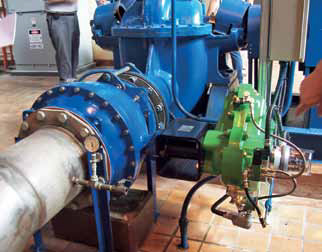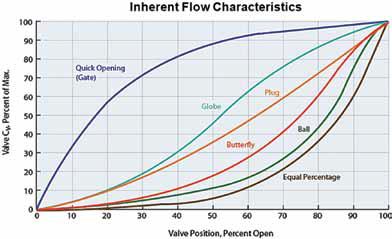Rubber-seated ball valve replacement saves energy, money and downtime.
Located in northwestern Ohio, the City of Findlay is the epicenter of Hancock County. Built in 1931, the Findlay Water Treatment Plant (WTP) was upgraded in 1965 and again in 1984. The Findlay WTP serves the 40,000 residents of the greater Findlay area and supplies an average of six million gallons of potable water per day and approximately 22,000 million gallons annually.
Water is pumped from the Blanchard River into the treatment plant, and then the raw water surplus is pumped into the Findlay Reservoir located three miles southeast of the Findlay WTP. The water in the Findlay WTP is treated and stored in the clear well and two, elevated storage tanks. Upon demand, potable drinking water is pumped to residents of Findlay using five motorized pumps ranging from 100 to 300 horsepower.

New rubber-seated ball valve, installed
The Problem
Each of the five pumps used at the WTP has a rubber-seated ball valve. Three are 10 inches and the remaining two are 12 inches. The seats on four of the five previously installed ball valves continually failed, leaked and were in constant need of repair.
After months of reworking and machining the seats, the Findlay WTP received what it hoped would be a final quote from the manufacturer for the significant but necessary repairs. Unfortunately, the cost to repair each valve was more than half the cost of completely replacing it with a new valve. Instead of the costly repairs, the WTP proposed a trial replacement of one of its faulty valves with a new type of rubber-seated ball valve.
The Solution
The new rubber-seated ball valve was precisely the solution: a reliable valve for surge control in a pumping application. For pumping systems in which surge control is critical, a pump control ball valve is typically used. The ball valve is wired to the pump controls and provides adjustable opening and closing times in excess of the system critical surge period.
Stable operating times are essential in controlling surges in pumping systems. The ball valve's inherent flow characteristics are highly suited to control flow and pressure. Equal percentage valves, such as the rubber-seated ball valve used at the Findlay WTP, uniformly changes the flow rate during the full travel.
Figure 1 provides the inherent flow characteristics of different valves whose data is expressed in terms of flow coefficient (Cv) at percentages of the valve's position. The most desirable flow characteristic for surge control is equal percentage, as provided by the ball valve.

Figure 1. Inherent flow characteristics of different valves
Features & Characteristics
The replacement ball valve was developed with more than 50 years of combined engineering, manufacturing, application and design experience. It features a seat retention system that provides positive mechanical retention of the valve seat while allowing easy adjustment or replacement.
Both single and double-seated valves are available for sealing in one or two directions. When fully open, the resilient seat is completely out of the flow stream. All these valves are interior and exterior coated with NSF 61 fusion bonded epoxy per AWWA C550 for the highest level of corrosion protection ensuring smooth flow surfaces and long life.
An important characteristic of valves in water pumping systems that is often overlooked is the valve's ability to minimize energy consumption. This valve is ideal when energy savings are a priority. When fully open, the valve provides a 100 percent clear flow area equal to the valve size. Therefore, the valve's head loss is equal to an equivalent length of pipe and will represent a significant savings in pumping costs.
This valve consumes less than 1 percent of the energy that a globe-style control valve consumes. Larger systems and systems operating at higher velocities will provide even greater savings.
The Results
The initial 12-inch rubber-seated ball valve impressed the Findlay WTP with its performance and energy savings. Subsequently, two 10-inch valves were installed with air-powered vane pneumatic actuators. According to Findlay WTP Supervisor, Jeff Newcomer, “Since the Val-Matic Ener•G Ball Valves were installed, they have been maintenance-free and working out great.”
This classic water treatment plant rehabilitation project not only generated energy savings, it eliminated the downtime necessary to repair the leaking seats.
Pumps & Systems, October 2011
